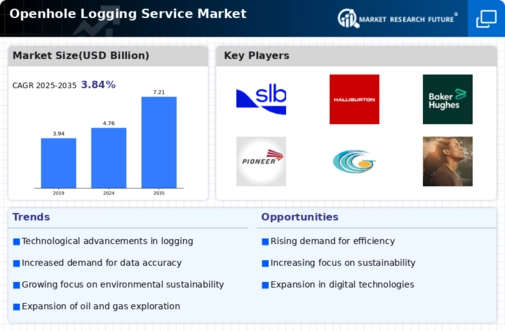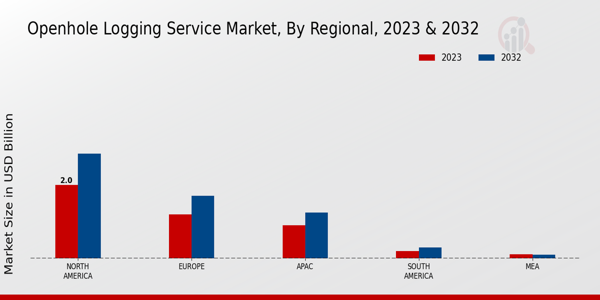Market Growth Projections
The Global Openhole Logging Service Market Industry is poised for substantial growth, with projections indicating an increase from 4.76 USD Billion in 2024 to 7.21 USD Billion by 2035. This growth trajectory suggests a compound annual growth rate (CAGR) of 3.84% from 2025 to 2035, reflecting the increasing reliance on openhole logging services in various exploration and production activities. The market's expansion is likely driven by factors such as technological advancements, rising energy demands, and the need for sustainable practices. As the industry adapts to changing market dynamics, the demand for innovative logging solutions is expected to rise, shaping the future landscape of the sector.
Rising Demand for Oil and Gas Exploration
The Global Openhole Logging Service Market Industry experiences a notable surge in demand driven by the ongoing exploration activities in oil and gas sectors. As countries seek to enhance their energy security, investments in exploration are increasing. For instance, the market is projected to reach 4.76 USD Billion in 2024, reflecting a robust interest in uncovering new reserves. This trend is particularly evident in regions rich in untapped resources, where openhole logging services play a crucial role in assessing geological formations. The industry's growth is likely to be sustained as exploration technologies advance, further driving the need for specialized logging services.
Regulatory Compliance and Safety Standards
The Global Openhole Logging Service Market Industry is significantly influenced by stringent regulatory compliance and safety standards. Governments worldwide are implementing rigorous regulations to ensure safe and responsible exploration practices. Compliance with these regulations necessitates the use of advanced logging services that provide accurate data on subsurface conditions. Companies that fail to adhere to these standards may face substantial penalties, thereby driving demand for reliable openhole logging services. As the industry evolves, the emphasis on safety and compliance is expected to intensify, further solidifying the role of logging services in maintaining operational integrity and environmental protection.
Growth in Unconventional Resource Development
The development of unconventional resources, such as shale gas and tight oil, is a significant driver for the Global Openhole Logging Service Market Industry. As traditional reserves deplete, the focus shifts towards these unconventional sources, which require specialized logging techniques to assess their viability. The market is expected to grow at a CAGR of 3.84% from 2025 to 2035, reflecting the increasing importance of openhole logging services in unconventional resource extraction. Companies are investing in advanced logging technologies to optimize recovery rates and ensure efficient resource management. This trend is likely to continue as the global energy landscape evolves, necessitating innovative approaches to resource evaluation.
Increasing Focus on Environmental Sustainability
The Global Openhole Logging Service Market Industry is witnessing a shift towards environmentally sustainable practices. As regulatory frameworks tighten globally, companies are compelled to adopt greener technologies in their operations. Openhole logging services are evolving to minimize environmental impact, with innovations aimed at reducing waste and enhancing resource efficiency. This trend aligns with the broader industry movement towards sustainability, which is becoming a critical factor in investment decisions. Companies that prioritize eco-friendly practices are likely to gain a competitive edge, as stakeholders increasingly favor environmentally responsible operations. This focus on sustainability may also lead to new market opportunities in the coming years.
Technological Advancements in Logging Techniques
Technological innovations significantly influence the Global Openhole Logging Service Market Industry, enhancing the accuracy and efficiency of logging operations. Advanced tools and methodologies, such as electromagnetic logging and nuclear magnetic resonance, are increasingly adopted, allowing for more precise data collection. These advancements not only improve the quality of subsurface evaluations but also reduce operational costs. As a result, companies are more inclined to invest in openhole logging services, anticipating a return on investment through improved exploration outcomes. The integration of artificial intelligence and machine learning into logging processes is expected to further revolutionize the industry, making it more competitive.
























Leave a Comment